Exploring Fiberglass Skimboards: Design and Performance
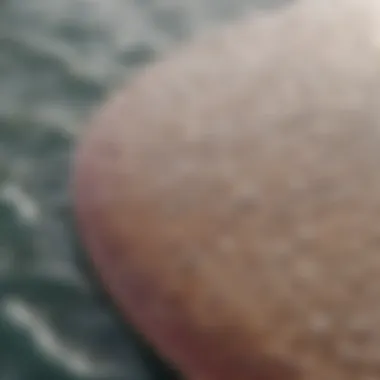
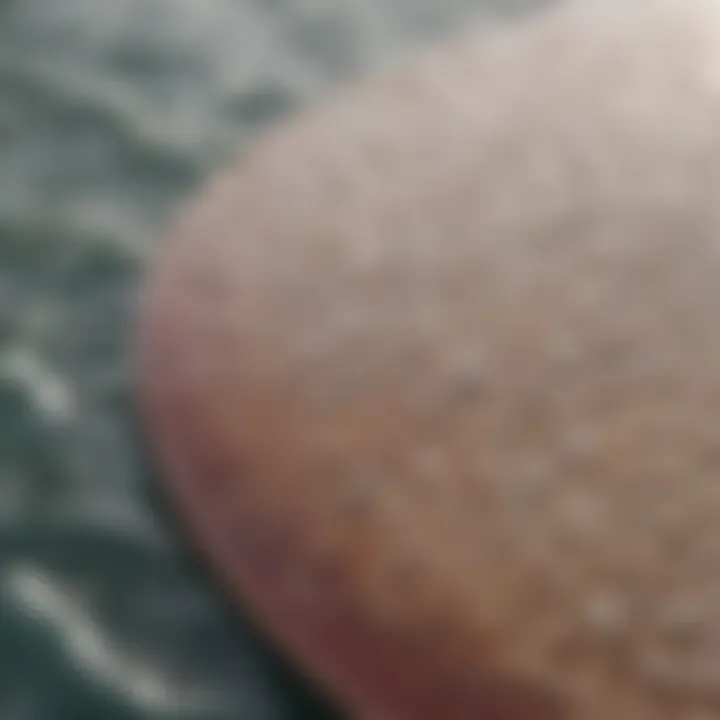
Intro
When it comes to riding the waves with finesse, fiberglass skimboards stand out as a top choice for enthusiasts. What sets fiberglass apart is more than just its shiny exterior; it’s about performance and adaptability. For those just dipping their toes into skimboarding or for seasoned pros pushing the limits, understanding the intricacies involved can enhance your experience on the water. This article will explore everything from the designs and materials to performance techniques, helping you figure out how to get the most out of your skimboard.
Techniques and Skills
Fundamental Techniques for Beginners
Starting out on a skimboard can feel a bit daunting, but once you get the hang of it, it’s a thrill like no other. Here are a few fundamental techniques to get your feet wet:
- Foot Placement: When standing on your board, the right foot positioning is crucial. Your dominant foot should be at the back, while the other foot remains near the front to help maintain balance.
- Body Weight Distribution: Shift your weight gently. Too much weight on the back heel may cause you to tip and fall.
- Paddle and Sprint: To ride effectively, you often need a running start. Practice sprinting toward the water while holding your board close. As you reach the edge, drop the board and jump onto it swiftly.
These techniques provide the foundation for a more enjoyable experience.
Advanced Skills for Experienced Athletes
As you grow more comfortable on the waves, it’s time to amp up your game. Here’s where advanced techniques come into play:
- Ole's and Spins: Mastering spins or “ole’s” can give you that extra flair. Timing is everything. Once you’re on the board, manipulate your body and weight to guide the board into a smooth rotation.
- Tricks and Jumps: When you’re feeling confident, explore jumps. Practice landing squarely on the board after a leap to maintain control and balance.
- Reading the Waves: A true skimboarder knows how to read the ocean. Observe how waves form and break to find the best spots for riding. This can greatly influence your performance and style.
"Understanding your conditions and board dynamics is the heartbeat of effective skimboarding."
Safety and Gear
Essential Safety Measures in Watersports
Safety should never take a back seat when it comes to skimboarding. Here’s a rundown of measures to consider:
- Personal Flotation Devices: Depending on where you're riding, consider wearing a life jacket. Some might scoff, but they can be a lifesaver, especially for beginners.
- Know Your Limits: Even the best can wipe out. Be aware of your skill level and don’t hesitate to stop if you feel overwhelmed or if conditions worsen.
- Surface Awareness: Not all beaches are created equal. Be cautious of uneven surfaces or debris that can cause injury.
Gear Reviews and Recommendations
Picking the right gear can set a solid foundation for performance.
- Hyperlight Skimboard: This model has a great mix of stiffness and flexibility for all levels. It’s super lightweight, allowing for more agile maneuvers.
- Sic Skimboards: Known for their innovation and quality materials, Sic boards offer impressive durability, making them suitable for both pros and novices alike.
- Official Skimboarding Skimboard Tents: While not directly related to riding, having the right accessories, like protective gear, makes a noticeable difference in your time on the water.
Each type of board has its own strengths and weaknesses. Doing your research will save you, and your wallet, some regrets in the long run.
This section provides an overview of the techniques you can practice and the safety measures you need to observe. With a little patience and dedication, you’ll be gliding across the water like a pro in no time.
Foreword to Skimboarding
Skimboarding, while often overshadowed by its more extravagant counterpart, surfing, holds a unique charm. It combines the thrill of gliding across the surface of the water with the excitement of speed and agility. This article aims to illuminate grim aspects of skimboarding and, in particular, fiberglass skimboards, diving into their design, material properties, and how they stand out in the world of boardsports.
When stepping into the realm of skimboarding, one engages not just in a sport, but in a lifestyle that melds community, skill, and an appreciation for the great outdoors. The significance of understanding skimboarding's foundational elements cannot be understated; they serve as the basis for more informed decisions whether you are a novice or a seasoned rider.
In this section, we will tackle the definition of skimboarding, trace its history, and discuss the resurgence of fiberglass skimboards—an innovation that transformed the sport's landscape. Not only does this set the stage for our deeper exploration, but it also highlights how materials have evolved to improve performance and accessibility for all riders.
Defining Skimboarding
Skimboarding can be best described as a surface water sport where riders use specially designed boards to glide over water, typically on the shore, before catching a wave. Riders run along the beach, drop their board onto the thin layer of water near the shore, and leap onto it, aiming to maintain balance as they carve across the water's surface.
Many enthusiasts find the appeal of skimboarding lies in its playful nature. Unlike surfing, purely dependent on waves, skimboarding allows participants to enjoy the water irrespective of sea conditions. It’s not just a sport; it's a dance with the ocean, emphasizing skill and creativity.
History of Skimboarding
The origins of skimboarding can be traced back several decades, starting in California during the 1920s. Originally known as "sand skimming," it involved riders gliding over the wet sand as waves receded. Early boards were simple wooden planks, often crafted from scraps or unused wood. Over the years, the sport grew in popularity, particularly along the coasts of California.
In the late 20th century, there was a notable transition. Riders began experimenting with more advanced materials, leading ultimately to the development of fiberglass boards, which not only enhanced performance but also broadened the sport's appeal. As skimboarding continued to evolve, its community thrived, giving rise to events, competitions, and a shared culture.
The Rise of Fiberglass Skimboards
With the arrival of fiberglass skimboards, skimboarding saw a shift that proved pivotal. Fiberglass, compared to traditional wooden boards, provided significant advantages—notably durability, buoyancy, and speed. Riders soon realized that fiberglass boards could withstand harsher elements and maintain performance over time, resulting in a boom in their popularity.
The lightweight nature of fiberglass also facilitated more intricate designs, permitting manufacturers to experiment with different shapes and sizes. This adaptability meant that riders could find boards tailored to their skill level and personal style.
As fiberglass skimboards took off, they bridged the gap between seasoned enthusiasts and newcomers, giving everyone easier access to the fun associated with skimboarding.
In summary, as we embark on our deep dive into the world of fiberglass skimboards, understanding the evolution and fundamentals of skimboarding establishes a firm foundation for appreciating the following sections that cover the material properties, design characteristics, and performance considerations inherent to this exciting sport.
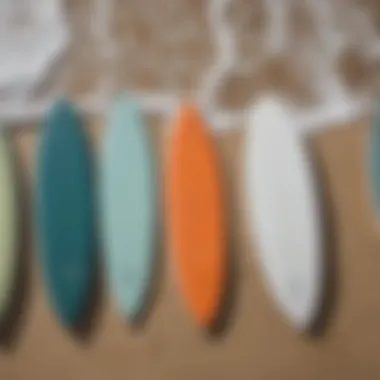
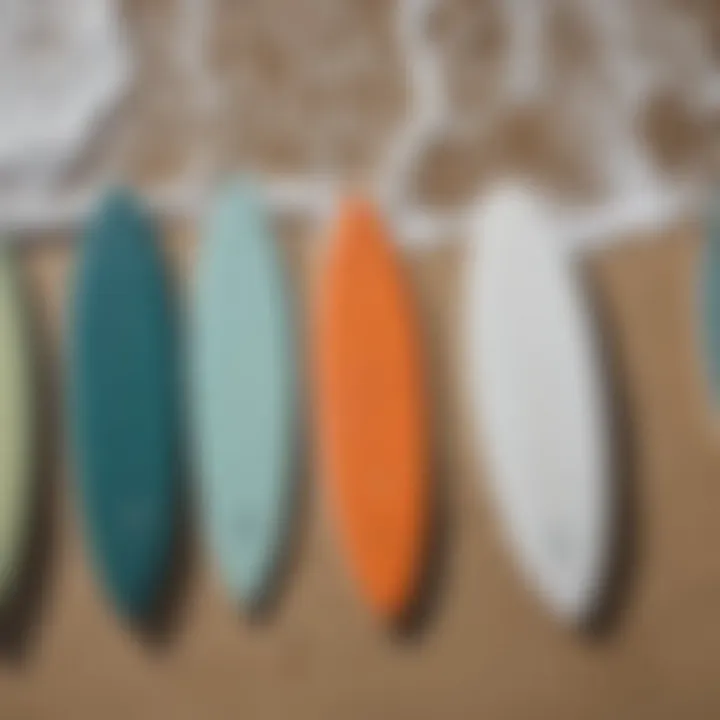
Understanding Fiberglass as a Material
Fiberglass has carved a niche for itself in various sports, especially skimboarding, thanks to its unique properties. Understanding fiberglass, especially in the context of skimboards, is pivotal. This material blends resilience with lightweight attributes, making it a preferred choice among many skimboarders.
Properties of Fiberglass
Fiberglass is quite the wonder material. It’s made of fine strands of glass, woven together and mixed with resins. This blend results in an incredibly sturdy yet lightweight product. Here are some key properties that stand out:
- Strength: It boasts a high tensile strength, enabling boards to withstand the force of waves and rough landings without cracking.
- Lightweight: Despite its durability, it doesn't carry the weight of heavier materials like wood.
- Water Resistance: Fiberglass is innately resistant to water, meaning it won’t warp or absorb moisture as some other materials might.
- Flexibility: This material can be engineered to offer different flex patterns, which can significantly affect riding experience and performance.
For enthusiasts, these characteristics can significantly influence how a board performs in various conditions. Whether it's choppy waters or smooth waves, fiberglass provides a consistent experience.
Comparative Analysis with Other Materials
When it comes to skimboarding, fiberglass often sits atop the material hierarchy, but it’s keener to understand how it measures up against other options. Here’s how fiberglass stacks up:
- Wood: Traditional wooden boards tend to be heavier and can absorb water. They often require more maintenance and can warp over time. In contrast, fiberglass remains light and maintains its shape in wet conditions.
- Plastic: While plastic skimboards are often more affordable, they can lack the performance and durability of fiberglass. Plastics may bend easily under pressure and don't offer the same feedback while riding.
- Carbon Fiber: This is another lightweight alternative, but it often comes at a higher price point. Carbon fiber boards can be incredibly stiff, providing a different riding experience than that of fiberglass, which can be manipulated for flexibility.
Understanding these differences helps riders make informed choices based on their skill levels and the conditions they face. The choice of material can shape the entire skimboarding experience.
"Each type of board has its own flavor, and knowing the ingredients helps riders choose their preferred dish."
By grasping the attributes and intricacies of fiberglass, skimboarders can appreciate what makes their boards unique, aiding in better equipment selection and enhancing overall performance.
Design Characteristics of Fiberglass Skimboards
Design plays a crucial role in the performance and enjoyment of fiberglass skimboards. This section unravels the essentials behind the design characteristics that set these boards apart from others. Understanding the specifics empowers riders, whether they're just starting out or weathered pros, to make a choice that aligns with their skill level and surfing conditions.
Shape and Size Variations
The shape and size of a skimboard influence not just aesthetics, but also its performance on the waves. When it comes to shape, there are several profiles that skimboarders can choose from:
- Nose Shape: Skimboards often feature either a pointed or rounded nose. Pointed noses facilitate a quicker an quicker cut through the water, enhancing speed. On the other hand, rounded noses provide more stability, making them a great choice for beginners.
- Tail Design: The tail can come in different forms too, including squared, rounded, or fish tails. Each tail design affects how the board exits the wave. A square tail offers more grip, ideal for tricks, while a rounded tail promotes smoother slides and turns.
- Width and Thickness: Thicker boards float better, making them good for learning. Conversely, thinner ones offer more control for experienced riders who crave precision. Some boards cater to specific riding styles, like wave skimming versus flatland tricks.
In terms of size, measuring across a board’s length and width can help determine the best fit.
- For taller or heavier riders, longer and wider boards often provide the necessary buoyancy and stability. Conversely, skimmers seeking to perform advanced maneuvers might opt for shorter boards, as they offer better maneuverability.
In essence, savvy skimmers can maximize their experience by choosing a board shape and size that suits their individual preferences.
Construction Techniques
The construction technique of fiberglass skimboards plays a pivotal role in ensuring durability and functionality. The typical process involves layering fiberglass on a core material, usually made from foam or wood.
- Layering Fiberglass: Often, a combination of woven fiberglass sheets is used. This layering contributes to the board’s strength and flexibility,
- Resin Application: Epoxy resin is typically employed in the process to bond the fiberglass layers together, enhancing durability while keeping the board lightweight.
- Core Choices: The choice between foam or wood core affects the overall ride. Foam cores are lighter and buoyant, ideal for many beginner to intermediate riders. Wooden cores, on the other hand, provide a unique feel; while heavier, they're generally more resistant to impacts.
- Fin Placement: Finally, the positioning of fins can considerably shape your ride. Fins enhance stability and control, allowing experienced skimmers to harness speed more effectively.
"Understanding how the design and construction of your fiberglass skimboard impacts ride and performance is key to enjoying this thrilling sport."
Performance Considerations
When it comes to skimboarding, performance isn't just a buzzword—it's the heart and soul of the sport. Performance considers how well a board interacts with the environment, the rider’s skill level, and the conditions of the water. The nuances in performance can make the difference between gliding gracefully along the shoreline and wiping out in a spectacular fashion. Every rider, whether they're just starting out or have been at it for years, needs to understand these performance aspects to truly enjoy the thrill of skimboarding.
Impact of Board Design on Performance
The design of a fiberglass skimboard plays a pivotal role in its overall performance. This is not merely about aesthetics; it's about how the board handles in different conditions. A board’s shape, width, and thickness can significantly affect its speed, maneuverability, and stability.
- Shape: Various shapes provide different experiences. For instance, a wider board offers more stability, which can benefit beginners. On the other hand, a longer, narrower board is suited for advanced tricks and speed.
- Rocker: The curvature of the board, known as rocker, can impact how it slices through the water. A board with more rocker may perform better in choppy conditions, while a flatter board usually excels in calm waters.
- Material Quality: The type of fiberglass used also makes a difference. Higher-quality fiberglass might add to the board's durability and reduce flex—greater durability means the board can handle more aggressive riding conditions.
Ultimately, the right board design enhances the rider’s capabilities, making it easier to execute tricks, maintain speed, and stay balanced. It is worth taking the time to experiment with different designs to find what resonates best with your personal style and environment.
Ideal Conditions for Fiberglass Skimboarding
Selecting the optimal conditions for skimboarding can greatly elevate the experience. Certain environmental factors can either complement or hinder performance. Here are a few considerations:
- Wave Height: Generally, small to medium waves are ideal for beginners, while more experienced riders might seek larger swells that offer more power and challenge.
- Wind Conditions: Calm days are often preferred, as excessive wind can affect stability and control. However, some riders thrive in challenging conditions, using wind to boost their tricks.
- Beach Type: A sandy, gradual incline is best for skimboarding. Rocky beaches often offer more hazards, while a flat stretch of sand allows for smoother take-offs and landings.
- Tide Levels: Low to mid tide is usually ideal, as it provides more exposed sand for launch. Higher tides can create more unpredictable water conditions.
In sum, knowing how these elements affect fiberglass skimboarding can sharpen your skills and refine your experience. By aligning your practice with ideal conditions, you transform your skimboarding journey into something remarkable.
"The joy of skimboarding embraces both the thrill of the sport and the serenity of nature's elements."
Skill Levels and Equipment Selection
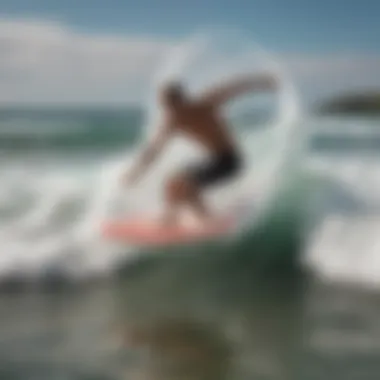
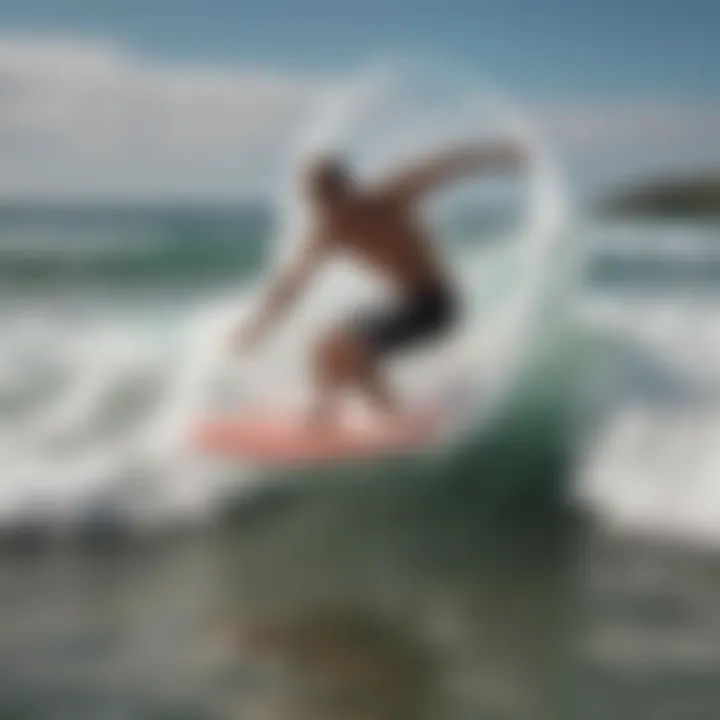
Understanding the skill levels associated with skimboarding is crucial when selecting the right equipment. Differentiating between beginners and more experienced riders not only enhances the overall experience but also promotes safety on the water. Each rider, regardless of their ability level, deserves a board that aligns with their skills and goals. Without proper alignment, a novice might struggle unnecessarily, while an advanced rider could feel hindered by gear designed for less experienced users. Therefore, making informed choices in equipment selection is paramount.
Choosing the Right Skimboard for Beginners
For those just starting their skimboarding journey, the array of available options can be quite daunting. Here are some key factors that beginners should look into:
- Board Size: A wider board offers more stability, making it easier for newcomers to find their balance. In general, opting for a board size that is about knee-high can be a good indicator for beginners.
- Materials: While fiberglass skimboards provide superior performance, they are often pricier. Beginners might consider options made from foam or wood which are more forgiving during falls and can build confidence.
- Design: A flat, broader design typically aids in stability, whereas thinner boards allow for more maneuverability as skills improve. Beginners should lean towards the wider designs initially.
- Weight: A lighter board is often easier to maneuver. This is especially important for those still learning techniques.
"Choosing a board that feels comfortable is just as important as skill. Comfort breeds confidence."
The goal is to acclimatize to skimboarding without overwhelming the rider. As ability grows, the choice of equipment can shift towards fiberglass, enhancing performance.
Advanced Techniques and Equipment for Experienced Riders
Once a rider has mastered the basics, the quest for advanced techniques begins. With this progression comes the need for more specialized equipment to suit their rising skills:
- Performance Boards: Advanced skimboarders might prefer lightweight fiberglass boards with a hydrodynamic shape. These allow for better speed and agility, which is essential for tricks and sharp maneuvers.
- Tail Shapes: Many experienced skimmers opt for boards with swaller tails, which enhance turning potential. Understanding how different tail designs impact rideability becomes imperative at this stage.
- Custom Options: Riders may start to consider custom boards, tailored to specific riding styles. This can involve factors like length, width, and specific dings desired for performance enhancements.
- Trick-Friendly Boards: Those who want to dabble in aerial tricks need equipment that can withstand rigorous handling. Fiberglass boards, when well-constructed, can offer durability while remaining lightweight enough to help with lifts.
In summary, as skills evolve, so does the need for equipment that challenges and supports the rider. Making the right choices not only augments performance but can also help prevent injury, ensuring a fulfilling skimboarding experience.
Maintenance and Care for Fiberglass Skimboards
Maintaining and caring for your fiberglass skimboard is not just a chore; it's pivotal in ensuring its longevity and performance. Skimboards are generally made to endure rough terrain and saltwater, but neglect can lead to deterioration that affects how well the board performs. Proper care is like a good insurance policy—it helps prevent unexpected costs down the line. Regular maintenance can keep your skimboard in top shape, improving your on-water experience and allowing you to push your boundaries.
Routine Maintenance Checks
Regular checks are crucial for identifying wear and tear before it becomes a more significant issue. Here are some essential checks to incorporate into your routine:
- Visual Inspection: After every session, take a few minutes to examine your board.
- Cleaning: A fresh rinse can go a long way.
- Storage: How you store your board can make a big difference in its lifespan.
- Look for any cracks or scratches on the surface. Small nicks can lead to larger cracks if they’re not addressed.
- Check the rails; these are often the first to get damage during use.
- Rinse your board with clean water to wash off sand and salt. Salt can erode the fiberglass over time.
- Avoid using abrasive materials when cleaning; they could scratch the surface and weaken the board’s integrity.
- Keep it out of direct sunlight for prolonged periods to prevent warping and fading.
- Store it flat or upright instead of leaning it to prevent any unwanted bends or dents.
Repairing and Refurbishing Techniques
Even with diligent care, wear and tear are part of the game. Knowing how to repair your fiberglass skimboard will save you money and keep you shredding through waves. Here are some techniques to consider:
- DIY Repairs: Basic repairs can typically be done with some effort and the right materials.
- Professional Repair: For more significant damage, it might be best to consult a professional. Especially if the integrity of the board is at stake, this investment could prevent further issues.
- Regular Refurbishing: Like any high-performance equipment, periodic refurbishment can extend the life of your skimboard.
- For small cracks or dings, a fiberglass repair kit can do wonders. These kits often come with resin, hardeners, and sometimes even sandpaper.
- Sand the area around the crack gently, apply the resin as per the instructions, and then allow it to cure completely before taking the board back to the water.
- Look for local shops specializing in board repairs. They often have experience and can restore your board nearly back to its original state.
- This might include stripping the old fiberglass and resin and replacing it with new layers to enhance durability.
- If you're considering revitalizing an older board, reach out to enthusiasts and forums to get tips from experienced riders. You can often find discussions on reddit.com that delve into specifics about different repair techniques.
"Proper care and timely repairs can mean the difference between a board that lasts a season and one that lasts for years."
Overall, the culture of maintaining your equipment instills a mindset geared toward improvement, not just on the waves but off them, too. Treating your fiberglass skimboard right will surely pay off in both fun and performance.
Safety Measures in Skimboarding
When it comes to skimboarding, safety measures play a role more vital than knowing how to do a good kick-turn. The open water, shifting sands, and the unpredictable nature of waves make it an exhilarating but potentially hazardous sport. Safety is not just a buzzword but a necessity that can mean the difference between enjoyable rides and serious injuries. This section tackles the risks associated with skimboarding and provides essential recommendations on maintaining safety while on the water.
Understanding the Risks
Entering the water for skimboarding is like stepping into a dynamic environment where conditions can change in a blink. Several factors can contribute to risk, including
- Wave Conditions: Strong currents and large waves can throw even the most seasoned skimboarder off balance, leading to potential accidents.
- Surface Hazards: Areas with rocks, sharp shells, or even debris can make landings challenging and dangerous.
- Inexperienced Riders: Newcomers might not be aware of their limits or the board’s capabilities, increasing the chance of injury.
- Environmental Factors: Things like weather changes, especially lightning storms or heavy winds, can create unsafe conditions unexpectedly.
A solid understanding of these risks allows riders to make informed decisions about when and where to skimboard. Observing conditions before venturing out can save a lot of trouble later on. Always look to see how the waves are behaving and check for other people in the water. You gotta keep your eyes peel for what’s going on around you.
"Safety isn’t just a slogan; it’s a practice that keeps the sport alive for everyone."
Safety Gear Recommendations
Employing the right gear can significantly mitigate risks and help ensure a safer experience on the waves. Here are some safety essentials to consider:
- Helmets: These protect the head during falls or collisions with other surfers or hard surfaces.
- Wetsuits: Aside from keeping you warm, they can also provide some padding. A thick wetsuit may lessen the impact from falls and cuts.
- Footwear: Wearing water shoes can protect your feet from sharp objects, as well as provide better grip on the board and in slippery conditions.
- Leash: A strong leash secures your board, preventing it from becoming a projectile in case of a wipeout.
- Sunscreen: Let's not forget proper skin protection! Extended time in the sun can lead to serious burns.
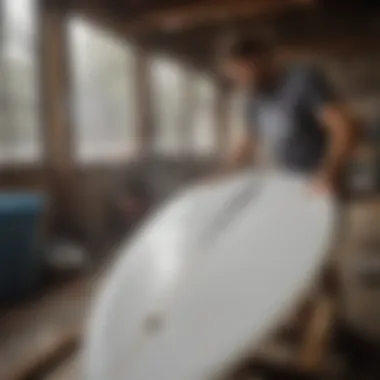
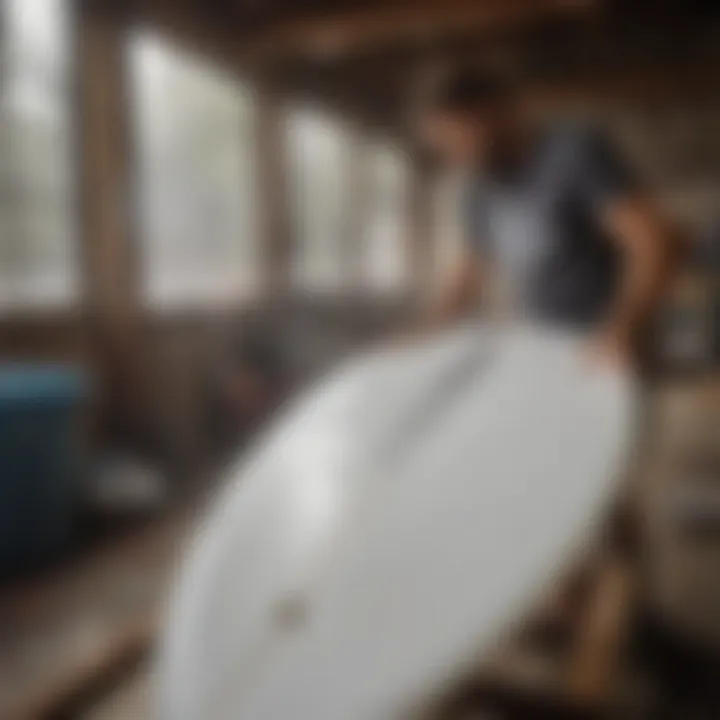
In addition, be mindful of personal limitations. Rushing to keep up with advanced riders, especially if you're a newbie, can lead to accidents. Always follow guidelines at your skimboarding locale and consider knowing some basic first aid. But not all heroes wear capes, so if you’re in trouble, seeking medical help is always the best option.
By implementing these safety measures, skimboarders can enjoy the thrill of the sport while minimizing risks. After all, the goal is to have fun, not wind up in the first aid tent.
Environmental Considerations
Environmental concerns play a pivotal role in the world of skimboarding. As outdoor sports enthusiasts navigate coastal and marine environments, choosing the right locations and being mindful of their impact becomes a shared responsibility. Understanding these elements not only enhances the experience but ensures these beautiful landscapes remain intact for future generations.
Choosing Skimboarding Locations
Selecting the perfect skimboarding spot isn't merely about the waves and the shore; it's about respecting nature. When choosing a location, consider the following factors:
- Local Regulations: Some beaches have restrictions on skimboarding to protect wildlife habitats or to maintain the natural ecosystem. Always check local rules and regulations before heading out.
- Environmental Impact: Look for locations that offer soft sand or well-maintained beaches. Avoid fragile dune ecosystems or coves where skimming might cause erosion or disrupt local flora and fauna.
- Safety and Accessibility: Some areas might be off-limits due to safety concerns, such as strong currents or rocky shores. Be sure to choose a place that is not only fun but also safe for all riders.
- Community Awareness: Engage with local skimboarding communities online or in forums like reddit.com or facebook.com to gather insights on less trafficked spots that minimize environmental impact.
By being selective about where you skimboard, you can contribute positively to your sporting environment.
Sustainability in Skimboarding
Sustainability in skimboarding might initially seem like a far-fetched idea, but it integrates seamlessly into the consciousness of the modern rider. Here are a few strategies to consider:
- Eco-Friendly Gear: Many companies are pivoting towards sustainable materials for skimboards, including recycled plastics and wood. Brands like Earth Technologies are at the forefront of this shift, crafting boards that minimize ecological footprints.
- Waste Management: Always pack out what you pack in. It may seem trivial, but disposing of waste properly can significantly benefit your chosen skimboarding locations. Bring reusable bottles and bags to cut down on single-use plastics.
- Clean-up Initiatives: Participate in beach clean-ups or local conservation efforts. Many skimboarding communities organize events that bring enthusiasts together, combining their love of the sport with environmental stewardship.
At the heart of sustainable skimboarding is a commitment to preserving the very environments we enjoy. The power lies in individual actions and the ripple effects they create when we unite collectively for a cause.
"Every wave we ride and every skimming board we use can make a difference. The choice to be mindful restores balance to our natural playgrounds."
The Culture of Skimboarding
When we talk about skimboarding, it’s more than just a sport; it’s a culture. This culture is woven into the fabric of community, creativity, and passion for the sport. Skimboarding goes beyond simply riding on water; it embodies a lifestyle that reflects freedom, adventure, and connection to nature. Understanding this culture can enhance one’s experience, making it more meaningful as one grows connected to the sport and the various communities that nurture it.
Community and Events
In skimboarding, community plays a pivotal role. From informal beach gatherings to sanctioned competitions, these events foster camaraderie among skimboarders of all skill levels. The face-to-face interactions at these events help newcomers find mentors, learn skills, and build lasting friendships. Events often range from local meets to larger competitions organized in renowned skimboarding spots like California's coastline.
Why Community Matters
- Support and Learning: Being part of a skimboarding community allows individuals to learn from one another, whether it's mastering techniques or understanding gear maintenance.
- Shared Experiences: Skimboarding creates stories. Events become a backdrop for thrilling exploits, mishaps, and community celebrations.
- Encouraging Inclusivity: Every member, regardless of skill, can contribute to the culture, ensuring that everyone feels valued and included.
Participation in community events can vary from simple gatherings at local beaches to annual large-scale competitions like the International Skimboarding Tour (IST). Events not only provide the opportunity for participants to show off their skills but also gather spectators who share a love for the sport.
"The moments you spend at the beach with the skimboarding community will always be cherished, much more than the rides themselves."
Influence of Skimboarding on Watersports
The influence of skimboarding extends into the wider realm of watersports. While skimboarding itself is unique, its principles, techniques, and spirit have inspired and shaped other activities in the watersports community, from surfing to paddleboarding.
Key Influences
- Technique Development: Skills honed in skimboarding often help in developing balance and adaptability in different water conditions.
- Innovation in Equipment: As skimboards evolve, other watersport equipment is affected, leading to advancements that serve a variety of activities.
- Shared Culture: The lifestyle and community culture inspire enthusiasts across various watersports, emphasizing a deep respect for the environment and enjoyment.
In essence, skimboarding has left an indelible mark on the watersports world. By fostering a sense of community and showcasing innovative techniques and equipment, it serves as both a sport and a cultural touchstone for enthusiasts everywhere. Understanding this connects riders to a greater narrative of watersport culture, allowing them to appreciate their role within it.
Innovations in Skimboard Technology
The realm of skimboarding has always been a breeding ground for innovation. This is especially true when considering the technological strides made in the production and design of fiberglass skimboards. As designs evolve, so too does the performance and user experience, making these innovations key to understanding the sport's future.
Of significant importance is the relationship between material advancements and how they translate into real-world performance. Fiberglass, because of its resilience and lightweight nature, allows for the creation of boards that can cut through waves with an ease that was once unimaginable. Innovations such as advanced resin systems have increased durability, offering riders a more reliable product that withstands the rigors of aquatic sports.
Moreover, the introduction of CAD (Computer-Aided Design) technology allows manufacturers to experiment with different shapes and profiles directly correlating shape with speed, maneuverability, and stability. Users can now find boards tailored to specific conditions and skill levels, thanks to these precise design techniques. The customization aspect also plays a significant role; riders can choose boards that fit their unique riding styles.
Recent Advances in Materials and Design
As the sun rises on new engineering possibilities, several recent advancements in materials and design come to the forefront. For instance, manufacturers have begun integrating carbon fiber elements into skimboard construction. This hybrid method harnesses the strengths of both fiberglass and carbon fiber, resulting in boards that not only boast enhanced stiffness but also a lighter weight. The consequence? Improved responsiveness and a quicker pop off the wave.
Furthermore, the incorporation of epoxy resin further revolutionizes skimboard design. Unlike traditional polyester resins, epoxy offers superior adhesion, flexibility, and resistance to water absorption. These attributes mean boards stay intact longer, making them an admirable choice for both casual and hardcore skimboarders.
Additionally, advancements in surface texturing, such as the use of specialized grip pads or textured finishes on the board's surface, significantly boost traction. Riders can experience greater confidence while performing tricks because they are less likely to slip off their board during critical maneuvers.
"The future of skimboarding is as much about science and technology as it is about the thrill of the ride."
The Future of Fiberglass Skimboards
Looking ahead, the future of fiberglass skimboards seems bright. As technology continues to influence different elements of the sport, we can anticipate several notable trends. One such trend is likely to be the increased use of sustainable and eco-friendly materials in board construction. As environmental concerns grow, manufacturers may explore ways to minimize their carbon footprint while still delivering high-quality products. This could involve utilizing recyclable materials or creating new composites that don’t compromise performance.
Another exciting prospect involves further enhancement of smart technology integrated into skimboards. Imagine boards equipped with sensors that can provide real-time feedback on performance, helping riders to fine-tune their technique or track their progress throughout the season.
Furthermore, as the sport continues to attract enthusiasts from diverse backgrounds, we should see new markets emerging. This will likely drive manufacturers to cater to varying skill levels, offering more accessible options for beginners while maintaining sophisticated choices for the seasoned riders.















